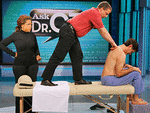
FAQ
Does Rolfing® Hurt? Contrary to popular misconception, Rolfing is not always painful. Any discomfort in response to Rolfing pressure is an indication of the amount of chronic tension stored in the tissues. It is the responsibility of the Rolfer to work within the level of tolerance of each client to accomplish the goals of the work. Most clients are not concerned about discomfort during the sessions. When the client’s level of tolerance is respected, the rolfer and client can work together to achieve better results.
Generally speaking, when chronic aches and pains are released, people feel much better. Rolfers use pressure and stretching to change and release the connective tissue. Often people will remember or "feel" an old injury or pain as it is released and that is followed by the feeling of relief and well-being as flexibility and balance is restored to those areas. This only lasts while the tightened tissue areas are releasing. Soon after, the client usually reports a sense of "warmth", "length", "lightness", tingling sensations and new freedom in the area worked on, as well as in surrounding areasas the changes spread through the connective tissue network. Clients report greater ease in movement and breathing, as well as improved balance and stability.
If I Get Rolfed, Will the Changes Last?The changes will not only last, but they even continue to improve! Here is how it works: The body's shape and condition is constantly being maintained and recreated by it's movement patterns. If the movement pattern are imbalanced and stressful they will continue to break down the structure. After Rolfing®, the movement patterns begin to improve or recreate a balanced structure. Through the improved movement patterns made possible by a more flexible structure, the Rolfing® continues after the 10 sessions have been completed.
What About my Bad Habits Won't They Pull My Body Back Out of Alignment?Firstly, your Rolfer will give you guidance on how to move and hold yourself in a way that will maintain and enhance the changes. Secondly, the body naturally will want to do what is more balanced and efficient because it will be more comfortable
Rolfing vs. Massage Massage is designed to decrease muscle pain and tension, increase circulation, and produce a sense of well-being. Its goal is relaxation and generally works with the muscular system. Massage can be therapeutic but it doesn’t ask the system to find new ways to organize itself. Rolfing® is a change process and simulates the physical structure to find new ways to organize, realign and move. Rolfing® is designed to be transformational. The goal of Rolfing® is to improve posture, flexibility, increase range of motion of joints, and educate clients in movement and self-awareness. It dissolves old patterns that cause harm and chronic pain. Rolfing® works with the connective tissue, which gives you the shape and support of your body. Massage can release tension in your muscles but Rolfing® addresses the source of that tension. Your muscles will only work as well as the connective tissue allows it to. And if the connective tissue is thick and rigid you cannot move efficiently nor relax properly.
Rolfing vs Chiropractor Traditional chiropractic has had as its focus the skeletal system. Dr. Rolf was most interested in the system of fascia, a connective tissue on our bodies. Fascia envelops and is interwoven throughout our skeletal muscles, surrounds our organs and lies adjacent to our skin. She believed that a majority of the time the skeletal system was being pulled out of place by soft tissue, muscles and fascia (the myofascial system), and so she focused her attention on this system. It has been my experience that Rolfing and chiropractic care can complement each other very well.
Rolfing - Can I perform my regular exercise? Regular exercise is usually OK, but it’s probably better not to run the Boston Marathon go all out for the Olympics until after your series is over. Sometimes during a series, your balance and coordination are shifting with your body as your structure changes. Athletic performance should improve after a series of Rolfing. It’s also not a good idea for someone to spend a week moving pianos or painting their entire house while in the middle of a series. Going for walks and dynamic exercises like Hata-Yoga, swimming, dancing can actually help integrate the changes from the sessions.
Rolfing - Who can receive it? From the very young and into advanced age, Rolfing is for anyone looking for more ease of movement, wishing to explore their potential, and for those experiencing physical limitations in their daily lives.
Rolfing -How frequently should sessions occur?
Rolfing - How long are sessions? How will I feel after a session? Sessions usually last for about 60 to 75 minutes. I include some movement education with every session. Sometimes people get very energized after a session or very tired (they are surrendering to gravity). It is best not to eat right before a session. Rolfing Can I receive other bodywork while I'm doing this? It is probably better not to receive any other form of deep tissue work during the basic series. Often Rolfing will make it easier for your regular massage therapist to work on you after the series is done. As well, if you receive Rolfing and other therapies at the same time you will not really be able to tell, where certain changes are coming from.
|

Certified Rolfer®
Vincent Lee
Rolfing was featured in


“Two Hands” 2007 Academy Award. Nominated for documentary film.

Andrew Weil, M.D.
“Good Morning From Dr. Weil.com” An on-line daily newsletter published a health news brief June 25, 2004--“Tip: Is Your Posture Bad? Today’s Tip-Rolfing."